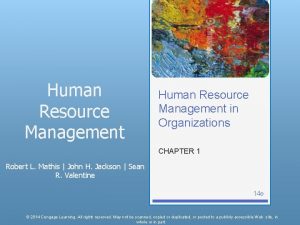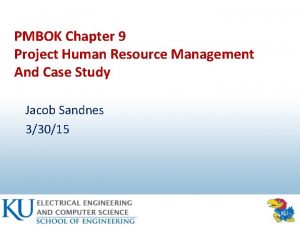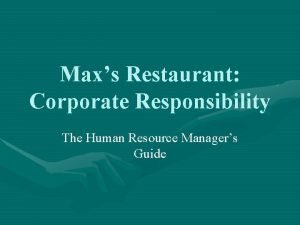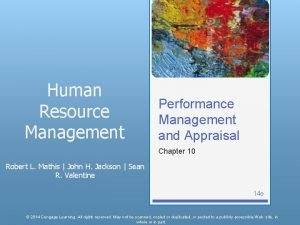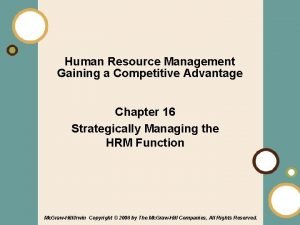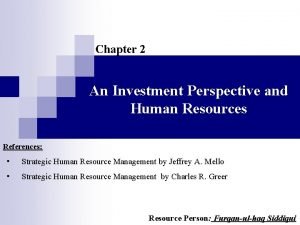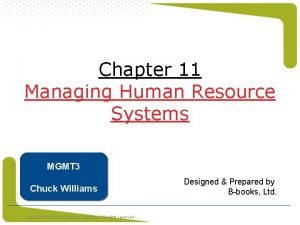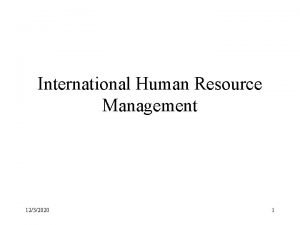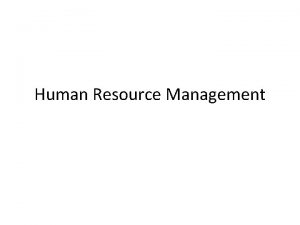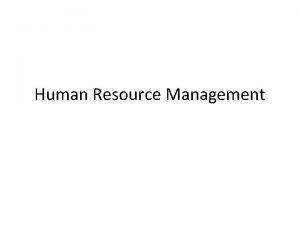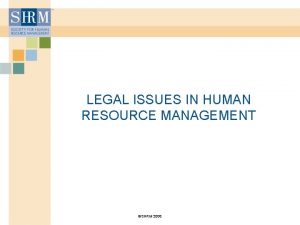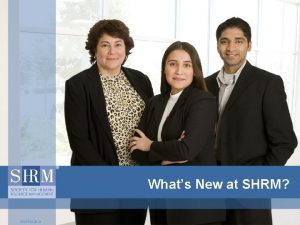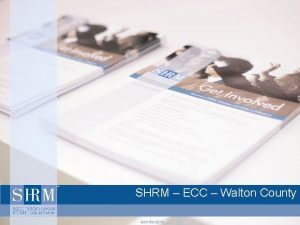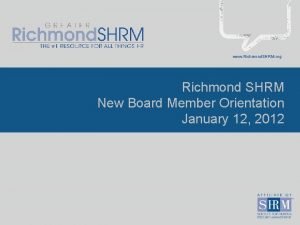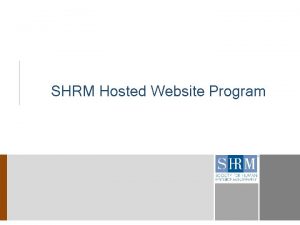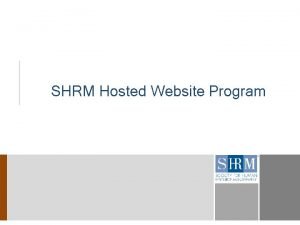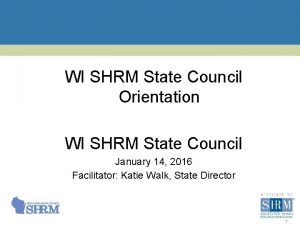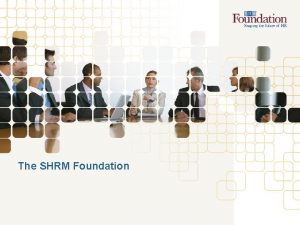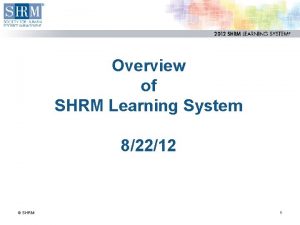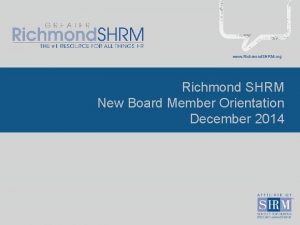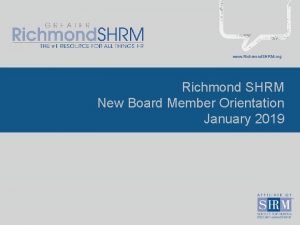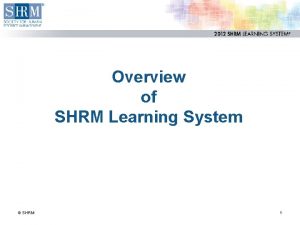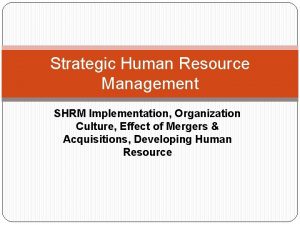LEGAL ISSUES IN HUMAN RESOURCE MANAGEMENT SHRM 2008








































- Slides: 40

LEGAL ISSUES IN HUMAN RESOURCE MANAGEMENT ©SHRM 2008

Session 1 ©SHRM 2008

PURPOSE The purpose of this module is to introduce students to common legal issues faced by HR professionals. ©SHRM 2008

EMPLOYMENT DISCRIMINATION • U. S. employees have legal protections against employment discrimination at the state and federal levels. These protections come from laws (statutes) and from court cases. • Protections at the state level vary from state to state. Even some municipalities have laws (ordinances) that protect employees from discrimination. ©SHRM 2008

EEOC • In the U. S. , the Equal Employment Opportunity Commission (EEOC) is the main enforcer of employee civil rights. • Each year, the EEOC receives thousands of complaints from employees alleging employment discrimination. ©SHRM 2008

EEOC Once the EEOC receives a complaint, one of three outcomes may occur: • The complaint can be dismissed as unfounded. If the complaint passes the initial review, the EEOC can either: • Have its own attorneys handle the case; or • Issue the complainant a Right-to-Sue letter. ©SHRM 2008

PROTECTED CLASSES Protected class: To receive employment discrimination protection under federal legislation, an employee must be a member of a class of individuals intended to receive protection. Generally, protected classes are age, race, gender, religion, color, national origin, disability and ethnicity. ©SHRM 2008

FEDERAL LAWS • Civil Rights Act of 1886 (Section 1981) – Prohibits discrimination on the basis of race, color, national origin, ethnicity. • Equal Pay Act of 1963 – Requires employers to pay employees equal pay for equal work regardless of gender. • Civil Rights Act of 1964 (Title VII) – Prohibits discrimination based on race, color, religion, sex (gender), or national origin. • Age Discrimination in Employment Act of 1967 – Outlaws discrimination in employment against individuals over 40. • Rehabilitation Act of 1973 – Prohibits employment discrimination against individuals with disabilities. ©SHRM 2008

FEDERAL LAWS • Pregnancy Discrimination Act of 1975 – Prohibits discrimination based on pregnancy and childbirth. • Uniformed Services Employment and Reemployment Rights Act (USERRA) of 1994 – Grants employees who have served in the military the right to be reinstated to their employment without losing benefits. • Americans with Disabilities Act (ADA) of 1990 – Prohibits discrimination against employees and job candidates with disabilities and requires employers to make reasonable accommodations unless they impose an undue hardship on the employer. ©SHRM 2008

FEDERAL LAWS • Civil Rights Act of 1991 – Expanded legal protections to employees; allows for punitive damages. • Family and Medical Leave Act (FMLA) of 1993 – Permits 12 weeks of unpaid leave for medical or family reasons. ©SHRM 2008

Theories of Employment Discrimination Under Title VII, there are two main theories of employment discrimination: • Disparate treatment: Under this theory, it is alleged that the employer intentionally discriminated against an employee (or group of employees) because of his/her race, color, religion, gender, or national origin. • Disparate impact: Under this theory, it is alleged that the employer’s human resource practices systematically exclude members of a protected class. ©SHRM 2008

Sexual Harassment Under Title VII, sexual harassment is a form of sex (gender) discrimination. There are two types of sexual harassment: • Quid Pro Quo (Latin for “this for that”): This type of sexual harassment occurs when a supervisor or other authority conveys to a subordinate (through either words or actions) that he/she must engage in sexual conduct in order to advance or to not receive poor treatment. ©SHRM 2008

Sexual Harassment • Hostile Work Environment: This type of sexual harassment occurs when an individual is subjected to the unwelcome and offensive behavior of others in the workplace. This may include offensive language, jokes, gestures, glaring, or displaying offensive images. This type of harassment typically comes from coworkers. ©SHRM 2008

Retaliation Title VII of the Civil Rights Act makes it unlawful for an employer to retaliate against an employee by taking an adverse employment action against a covered individual for engaging in any protected activity. Protected activities include such actions as filing a discrimination complaint, threatening to file a discrimination complaint or picketing to protest discrimination. ©SHRM 2008

Employment At Will vs. Due Process Most U. S. employees are employees at will. Under employment at will, an employee can be discharged for any non-discriminatory reason at any time. However, some employees are due process employees. Due process employees are generally unionized and/or civil servants. This category of employee can be disciplined (including discharge) only for cause. ©SHRM 2008

Affirmative Action Affirmative action programs are implemented as a means to remedy past discrimination. Some employers have adopted these programs voluntarily and others have been required to adopt them by the EEOC or court order. Some employers might be required to have an affirmative action program because they are federal contractors (Executive Order 11246). However, quota systems are unlawful because they have been found to violate Title VII. ©SHRM 2008

Employment Discrimination Defenses The following are some defenses an employer can use to defend Title VII cases: • • • Bona fide occupational qualification (BFOQ) Seniority Merit Employee misconduct Valid selection test ©SHRM 2008

U. S. Supreme Court Cases • Mc. Donnell Douglas Corp. v Green, 411 U. S. 792 (1973): Established the burden-shifting standard for disparate treatment cases. • Meritor Savings Bank v Vinson, 477 U. S. 51 (1986): A hostile work environment due to sexual harassment is a type of sexual discrimination. • Sutton v United Airlines, 527 U. S. 471 (1999): Minor illness/ailments are not disabilities as defined under the Americans with Disabilities Act. ©SHRM 2008

Employment Discrimination Review and Wrap-Up Many employment discrimination issues we discussed directly relate to the selection and staffing functions of the organization. However, employment discrimination can be found in other types of HR practices. What laws prevent discrimination in training and development, compensation and appraisal? Take the self-assessment quiz. ©SHRM 2008

Session 2 ©SHRM 2008

OTHER HR-RELATED LEGAL ISSUES • Compliance • Safety • Military Leave • Labor Relations • Employee Privacy • Negligent Hiring • Negligent Retention • Negligent Referral ©SHRM 2008

Compliance Recordkeeping • Employers must keep records on employees for a variety of reasons, including compensation (e. g. , payroll records), appraisals (past performance evaluations), and safety training. • Employers with more than 100 employees are required to file an annual report (EEO-1) that provides a numerical count of their employees by job category and by ethnicity, race and gender. ©SHRM 2008

Safety • In 1970, the U. S. Congress passed the Occupational Safety and Health Act. The purpose of this law is to help both employers and employees reduce on-the-job death and injury. • The law is administered by the Occupational Safety and Health Administration (OSHA), a division of the U. S. Department of Labor. ©SHRM 2008

Safety • OSHA provides both guidelines (optional) and standards (required) for employers. • Employers can be subject to both scheduled and random inspections by OSHA. ©SHRM 2008

Workplace Violence Employers have a responsibility to make the workplace as safe as possible. Part of this responsibility includes taking steps to prevent workplace violence. The employer who fails to do so is subject to possible liability. ©SHRM 2008

Workplace Violence Some steps employers can take to reduce workplace violence include: • Monitoring and security measures (e. g. , security guards, surveillance cameras, identification badges, passwordcontrolled entry). • Establishing a zero-tolerance policy on workplace violence. • Offering employee training on workplace violence avoidance and alternative dispute resolution tactics. • Establishing a zero-tolerance policy about being on the jobsite or performing work duties while under the influence of illegal drugs or alcohol. ©SHRM 2008

Military Leave • Uniformed Services Employment and Reemployment Rights Act (USERRA) (38 U. S. C. 4301) provides reemployment rights for veterans and members of the National Guard and Reserve following qualifying military service. – This law also prohibits employer discrimination based on current or past military service or based on one’s intent to join the military. ©SHRM 2008

Military Leave • Family and Medical Leave Act of 1993: In January 2008, the Family and Medical Leave Act was amended to include a provision that states “eligible employee shall be entitled to a total of 12 workweeks of leave during any 12 month period. . . because of any qualifying exigency (as the Secretary shall, by regulation, determine) arising out of the fact that the spouse, or a son, daughter, or parent of the employee is on active duty (or has been notified of an impending call or order to active duty) in the Armed Forces in support of a contingency operation. ” ©SHRM 2008

Labor Relations • Labor relations refers to the dealings between the management of an organization and its organized labor representative (e. g. , unions). • Unions exist in the public and private sectors. • The National Labor Relations Board was created by Congress in 1935 to administer the National Labor Relations Act, the primary law governing relations between unions and employers in the private sector. ©SHRM 2008

Labor Relations • The overall rate of unionization in the United States has been declining for decades. • Organizations have a duty under federal law to deal with unions fairly and to bargain in good faith. ©SHRM 2008

Labor Relations The National Labor Relations Act (NLRA) prohibits unfair labor practices, which are defined as activities by employers that interfere with the right to unionize by employees. Examples of unfair labor practices include telling employees to vote against unionization or threatening to close a facility if the workplace becomes unionized. ©SHRM 2008

Labor Relations Employers also have protections against unfair labor practices. For example, the Taft-Hartley Act of 1947 prohibits secondary boycotts and allows states to pass right-to-work statutes. Under the Taft-Hartley Act, closed shops (in which employees must be a member of the union before they are hired) are prohibited. However, states may allow union shops (in which the union requires that an employee become a union member within a certain amount of time – usually 30 or 60 days – of being hired). ©SHRM 2008

Employee Privacy Employees have a limited expectation of privacy in the workplace. • Email and telephone calls are normally not considered to be private. However, some states have wiretapping laws that offer limited protection for employee telephone calls. • Employees should expect privacy in restrooms and changing facilities. However, in some sectors, employees can be monitored for loss prevention. ©SHRM 2008

Employee Privacy • The Fourth Amendment of the U. S. Constitution has a provision on unlawful searches and seizures by the government. This provision has been interpreted by courts to mean that governmental workers have special privacy protections. • Employers with federal grants and contracts must have a drug free workplace policy pursuant to the Drug-Free Workplace Act of 1988. However, drug test results and other medical records must be handled appropriately and be consistent both with this act and the Health Insurance Portability and Accountability Act (HIPAA). ©SHRM 2008

Negligent Hiring • Employers have a responsibility to workers, clients, community and themselves to ensure that employees do not harm others in the performance of their work duties. • Under the legal doctrine of respondeat superior, an employer might be held civilly liable for the actions of employees. ©SHRM 2008

Negligent Hiring Many employers investigate the backgrounds of their employees before hiring them. Such practices include: • Checking references/contacting former employers. • Conducting a criminal background check. • Requesting transcripts. • When appropriate, requesting proof of licensure (e. g. , license to practice medicine or law, driver’s license). • Drug testing. ©SHRM 2008

Negligent Retention Related to the issue of negligent hiring is negligent retention. Negligent retention occurs when an employer does not discharge an employee after the employer learns (or should have known) that the employee was a danger to others. ©SHRM 2008

Negligent Referral Negligent referral occurs when an employer knows that a current or former employee poses a threat to others, but does not pass this information on to the next employer. ©SHRM 2008

Employee References • Giving employee references can pose a difficult situation for employers. On one hand, employers do not want to be sued for negligent referral by subsequent employers. On the other hand, employers want to avoid former employees bringing a lawsuit based on discrimination, tortious interference with contract (i. e. , interfering with an employee’s ability to obtain another job), or defamation. ©SHRM 2008

Review and Wrap-Up Discussion question: What are some important legal trends affecting HR? Student evaluation: Quiz on the materials from Sessions 1 & 2. ©SHRM 2008
 Current issues in human resource management
Current issues in human resource management Time management human resources
Time management human resources Retail human resources
Retail human resources Human resources defintion
Human resources defintion 2008 2008
2008 2008 Shrm performance management
Shrm performance management Resource management pmp
Resource management pmp Project human resource management pmbok
Project human resource management pmbok Important
Important Recruitment process of max's restaurant
Recruitment process of max's restaurant Induction definition in hrm
Induction definition in hrm Human resource management chapter 2
Human resource management chapter 2 Chapter 9 human resource management
Chapter 9 human resource management Hrms.shanker group
Hrms.shanker group Mbo performance appraisal method
Mbo performance appraisal method Ba human resource management
Ba human resource management Higher business management
Higher business management Human resources management gaining a competitive advantage
Human resources management gaining a competitive advantage Downsizing
Downsizing Human resource management gaining a competitive advantage
Human resource management gaining a competitive advantage Human resource management past exam papers
Human resource management past exam papers Management fifteenth edition
Management fifteenth edition Human resource management 15th edition
Human resource management 15th edition Gary dessler human resource management
Gary dessler human resource management Human resource management strategy and analysis
Human resource management strategy and analysis Investment orientation
Investment orientation Chapter 11 human resource management
Chapter 11 human resource management Human resource management chapter 1
Human resource management chapter 1 Chapter 1 introduction to human resource management
Chapter 1 introduction to human resource management Applied psychology in human resource management
Applied psychology in human resource management Human resource management overview
Human resource management overview Unit 3 human resource management
Unit 3 human resource management Seperation in hrm
Seperation in hrm Operations management chapter 10
Operations management chapter 10 Meaning hrm
Meaning hrm Human resource management weiterbildung
Human resource management weiterbildung Human resource management syllabus harvard
Human resource management syllabus harvard Human resource management syllabus harvard
Human resource management syllabus harvard Hrmis meaning
Hrmis meaning Definition human resource management
Definition human resource management Concept of hrm
Concept of hrm
